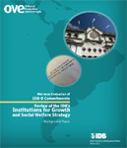IDB-9: Review of the IDB Institutions for Growth and Social Welfare Strategy
Date
Mar 2013
This paper reviews the 2011 Sector Strategy on Institutions for Growth and Social Welfare (SIGS) of the Inter-American Development Bank (IDB, or Bank). The Strategy was produced as a requirement of the IDB-9 agreement. The review finds that the Strategy replicates a number of patterns observed in prior sector strategies. SIGS represents the first time that the Bank uses a modern definition of institutions; however, the concept of institutions is not incorporated as a guiding principle for setting priorities. Like other strategies, SIGS largely reflects the current work of the Bank, and also reflects the most common ideas and thinking of the time. This said, SIGS also emphasizes areas of work that had not been central to the Bank before, such as work with transparency and work in formalizing firms. The Strategy document itself has strengths but also a number of deficiencies. SIGS is more specific than prior strategies, although it still proposes quite a broad spectrum of activities. It contains a good diagnostic of the needs facing small and medium-sized enterprises and of innovation, although diagnostics in most other areas are relatively weak. Although SIGS maintains the IDB-9's focus on the Bank's comparative advantage, it does not analytically assess that comparative advantage, and it presents no evidence that the sectors prioritized reflect any particular operational or structural advantage of the Bank--except that they mostly represent sectors in which the Bank already works. SIGS's results framework is very poor, largely reflecting the inadequacies of the IDB-9 results framework, as applied to institutions. SIGS was not designed as an operational strategy, so it does not assess the Bank's operational capabilities to respond to the Region's needs in priority areas. SIGS has had little impact on the way the Bank works. Bank staff is generally unaware of the Strategy, and those who are aware of it do not report using it as a main input in country dialogue or project preparation. The Institutions for Development Department (IFD) is an exception: its staff do report using SIGS. However, the review of IFD's portfolio does not show clear evidence that project selection has changed in favor of SIGS priorities. IFD has produced a significant body of analytical work, which in some cases addresses institutional issues. Nonetheless, IFD's approach to implementing 'intersector alliances' has not included directly working across Bank departments to strengthen institutions broadly in the Bank's work. However, SIGS has served a useful purpose as a mechanism to reemphasize the importance of the issue of institutions for the IDB, and, to some degree, to consolidate and demarcate the areas of work within IFD.



